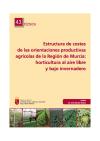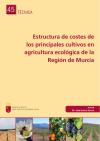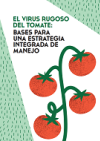Media library
Documentary, graphic and/or audiovisual knowledge objects are offered here, offering information on various sectors and topics. Use the keyword search or search filters to access current audiovisual and documentary knowledge objects useful for your implementation.
If you have any questions or suggestions, please contact us here.

Phytosanitary strategies in tomato
Strategies for the use of phytosanitary products in tomte cultivation

Cost structure of agricultural production areas in the Region of Murcia: stone fruit and citrus fruits
Publication dedicated to the cultivation of regional citrus and stone fruit trees

Cost structure of the agricultural production guidelines of the Region of Murcia: nuts, pome fruit, vines, and olives
Publication dedicated to the most characteristic woody crops of rural Murcia, including nuts, pome fruit, table and wine grapes, and olive trees.

Cost structure of agricultural production areas in the Region of Murcia: open-air and greenhouse horticulture
Publication dedicated to regional horticultural crops, both outdoors and under protected and greenhouse conditions.

Cost structure of the main crops in organic farming in the Region of Murcia
Document describing the main guidelines for regional organic farming in Murcia

Tomato rugose virus: bases for an integrated management strategy
Document with information on epidemiological aspects—such as plant infection, virus spread, alternative hosts, virus persistence in the environment, etc.—that are essential for understanding and framing.
Active ingredients allowed in integrated production for pome fruit trees and restrictions on use
Information on active ingredients in integrated production for pome fruit trees and restrictions on use
Active ingredients allowed in integrated production for stone fruit trees and restrictions on use
Information on active ingredients in integrated production for stone fruit trees and restrictions on use
Plant pest and disease advisories, beware of the possible introduction or presence of Tomato Rugose Fruit Virus (ToBRFV)
Organism under community emergency measures that causes symptoms on leaves and damage to tomato fruits
Plant pest and disease alerts: Presence of a large number of individuals of Mythimna unipuncta, a grass defoliating caterpillar.
A very voracious and polyphagous defoliating caterpillar that can affect both forage and horticultural crops, with prairies and grasslands, along with corn, being the most affected.
Plant Pest and Disease Advisories: Guatemalan Potato Moth Tecia solanivora
Tecia solanivora is considered a quarantine organism due to the potential phytosanitary risk it represents, constituting a serious threat to potato production by affecting and rendering tubers worthless, either during cultivation or in storage.
Notice of the first outbreak of Tomato Rugose Fruit Virus (ToBRFV) in the Region of Murcia (September 27, 2021)
Tomato brown rugose fruit virus (ToBRFV), a member of the tobamovirus family, was first detected in tomato crops in Israel in 2014 and in Europe in Germany in 2018. In 2019, it experienced a significant expansion when it was isolated in Italy, the Netherlands, Greece, and other Member States.
Rosaceae fire blight
Fire blight is a disease caused by the bacterium Erwinia amylovora that affects various species of the Rosaceae family, including pear, apple, quince, Japanese medlar, etc.
Drosophila suzukii treatment notice for cherry trees
In the various areas where Drosophila suzukii is being monitored, populations of this insect are being detected. Remember that attacks tend to be more intense and frequent at the beginning of the harvest, and treatment will be especially necessary in plots that were attacked in previous years and that left cherries unharvested last year (fly damage or cracking, lack of profitability, etc.).
Notice of treatment of plum moth (Cydia funebrana) in plum trees
The second generation of the plum moth has been seen flying between late May and early June in the Ribera and Val d'Albaida regions, and somewhat later in inland areas. Eggs will hatch this week and next. Treat accordingly.
Technical information on the potato flea beetle (Epitrixs pp.)
The potato flea beetle refers to several species of the Epitrix genus, which are primarily considered pests of potato crops, although they can also affect other Solanaceae crops such as peppers, tomatoes, and eggplants.
Fact sheet on Scirtothrips dorsalis
Scirtothrips dorsalis Hood, known as chili thrips, tea yellows, or flower thrips, is a harmful organism classified as a quarantine pest. It is an insect native to southern and eastern Asia and has a wide range of host plants (more than 150 species), including commercial crops such as beans, tomatoes, eggplant, cucumber, onion, and peppers.
Scirtothrips aurantii, information note and management recommendations, damage caused by thrips in citrus, persimmon and pomegranate.
Given the damage caused by thrips observed since May on leaves and fruit in various citrus, persimmon and pomegranate crops and the confirmation of the presence of Scirtothrips aurantii Faure in certain areas, the following recommendations have been considered appropriate:
Plant health, pest reports: Erwinia amylovora (fire blight)
Fire blight is a disease caused by the bacterium Erwinia amylovora that affects various species of the Rosaceae family, including pear, apple, quince, and Japanese medlar trees. It was detected in Cantabria in 2011 and is considered an extremely harmful disease.




